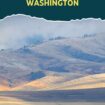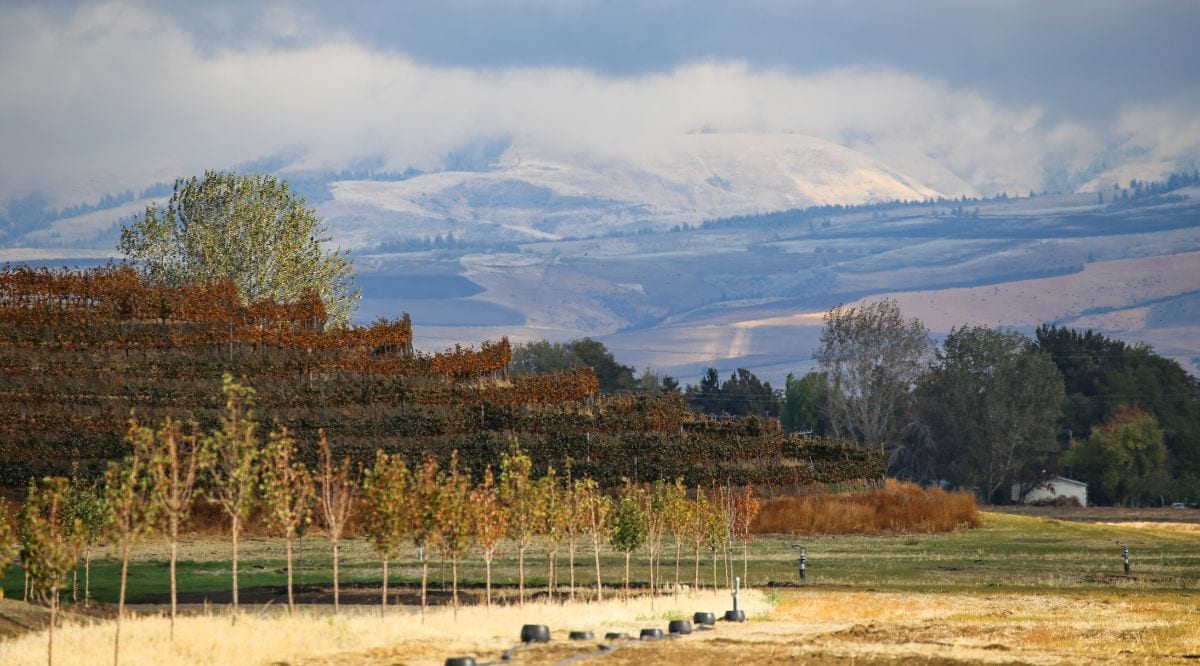
Go World Travel is reader-supported and may earn a commission from purchases made through links in this piece.
Most people go to Walla Walla for the wine. After all, the town is a viniculture mecca. Located in the southeast corner of Washington State, within highly regarded Washington Wine Country, the Walla Walla Valley features more than 130 wineries and nearly 3,000 acres of grapes.
Here’s where you can sip award-winning, robust flavors straight from the source, like Cab Sauvignon, Syrah, Merlot, Cabernet Franc, Malbec and more.
Credit the region’s prehistoric volcanic history and the catastrophic glacial Missoula floods for the Valley’s elevation, soil and climate, all key factors affecting a grape’s flavor and the resulting color, aroma and structure of the wine.
Walla Walla is a Wine Mecca
In the town’s charming and historic downtown, there are over thirty wine tasting rooms alone. They are al within walking distance of top-rated restaurants, eclectic shops and unique accommodations.
Once you leave the central hub, there are four other wine districts to explore nearby: Eastside, Southside, Westside and Airport, each with its own distinct characteristics. And another, the Rocks district of Milton-Freewater, is right across the border in Oregon.
If you don’t know by now, wine is always in reach wherever you are in Walla Walla!
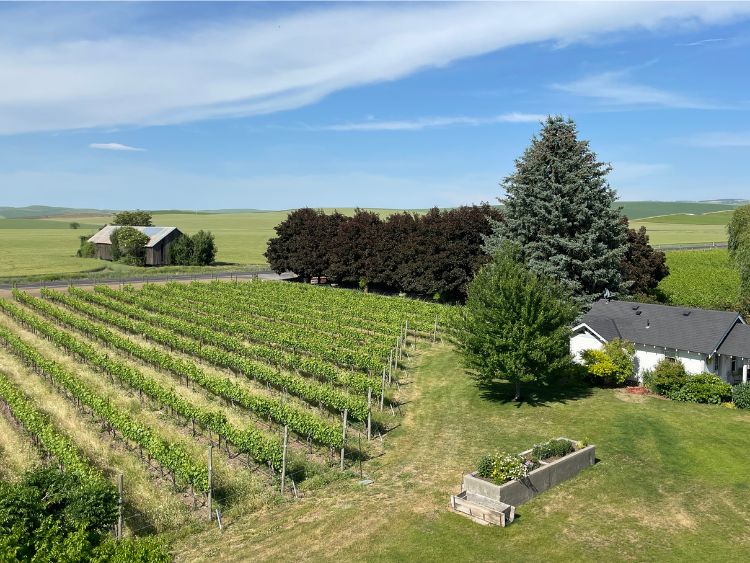
Wine Tasting at Abeja
One of the most memorable wine experiences I had during my visit to Walla Walla was at Abeja. Located in the foothills of the Blue Mountains on a lovingly restored, century-old farmstead, surrounded by golden wheat fields, this beautiful 39-acre site is home to celebrated Abeja Winery and The Inn at Abeja.
Abeja is Spanish for a bee. The winery’s founders, Ken and Ginger Harrison, chose the name to remind us of the honey bee’s significance in caring for the environment and to honor the value placed on working cooperatively as a community.
Best Tips & Tools to Plan Your Trip
The winery is picturesque with vineyards, creeks, gardens, lavender fields and views as far as the eye can see. It’s a serene setting, ideal for wine tasting, weddings and romantic getaways.
For wine tasting sessions (by appointment only), visitors can choose from two experiences: the Traditional Abeja Tasting or the Abeja Estate Experience (the latter is offered April – October). The first includes a seated tasting in the historic, handsome barn. You’ll enjoy a selection of current release wines from the Beekeeper and Columbia Valley collections, along with a brief overview of Abeja.
Abeja Estate Experience
The Abeja Estate Experience starts with a tour of the property and an overview of the history behind the 1900s farmstead. Then you’re led into the barn for a tasting flight of a selection of limited-release estate and library wines. Each of which are paired with a small bite prepared by Abeja’s Executive Chef Jake Crenshaw.
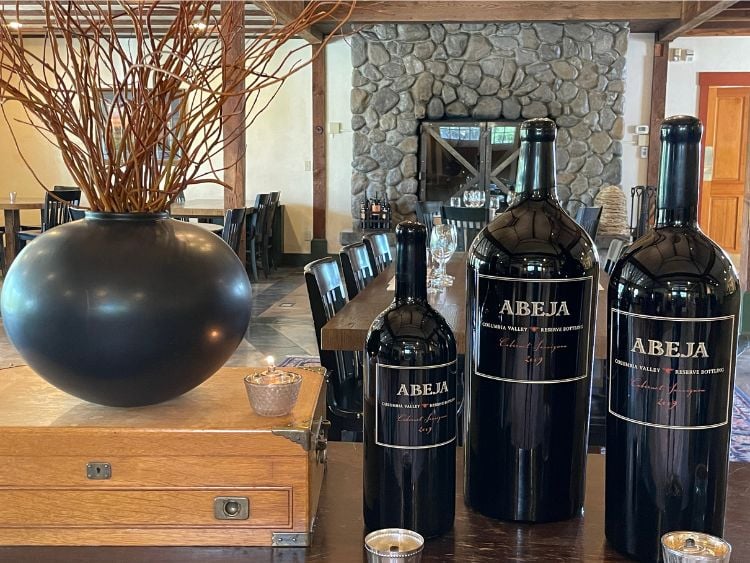
Traditional Abeja Wine Tasting
I did the traditional experience, which was perfect in every way. It provided a thorough introduction to the site, its owners and winemakers, and the gorgeous wines. I tasted a crisp, light-bodied 2019 Washington State Chardonnay, which was just what I needed on a hot summer day.
It filled my palate with essences of peach, lime and tart apple and led to a long and rewarding finish. Next up was a 2021 Washington State Beekeeper’s Blend that was mostly comprised of Merlot, Cabernet Sauvignon and Cabernet Franc. It was fruit-forward and contained notes of berries and plum.
The third tasting was a 2020 Columbia Valley Merlot that had notes of dark fruit, herbs and chocolate. It wasn’t overly acidic or too bold, which I liked. And the final wine was a 2019 Columbia Valley Cabernet Sauvignon. It was very sophisticated with essences of cherries, pepper, walnuts and spice, and had a lengthy finish.
Read More: Wine Tasting and Giraffe Feeding in Malibu
There’s More to Walla Walla than Wine
While meandering around Walla Walla and experiencing its vino-centric vibes, many folks discover this small town is full of surprises. From fascinating historical sites, cultural attractions, and glorious nature and great outdoors, you’ll find the area is resplendent with options.
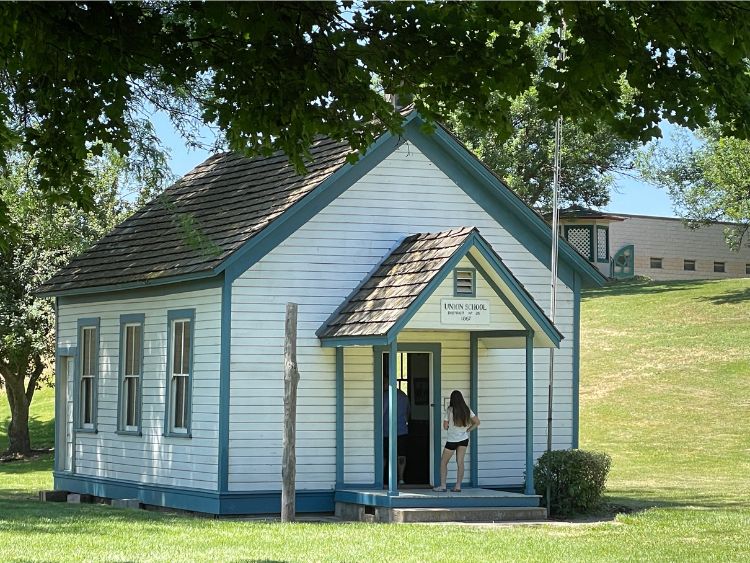
Fort Walla Walla Museum
If you’re a history buff, head to Fort Walla Walla Museum, where you’ll journey into the region’s rich heritage. Exhibits delve into military and living history, as well as horse-era agriculture. There are displays of turn-of-the-century quilts, period clothing and military uniforms, antique toys, and fur trade and gold rush artifacts.
There is also a diorama depicting the Lewis & Clark expedition that camped in the valley. The 9th Cavalry Buffalo Soldiers, stationed at the fort in the early 1900s, also have a dedicated section.
The museum holds old vehicles like buggies, wagons and sleighs, along with agricultural equipment and train cars. Among them are the Abbot-Downing Company stagecoach, or “mud wagon,” dating back to 1903; the Blue Mountain, Washington’s oldest existing locomotive, acquired in 1877; a combine with an impressive set of models of the 33 mules that pulled it and a horse-drawn steam pumper for the fire department from the early 1900s.
There’s also a cookhouse model, where you can imagine preparing meals in the heat and dust for the hard-working farmhands. And don’t miss the replicas of bucket cells (a mere 6 ft. by 7 ft. in size) used in the WA State Penitentiary in the late 1800s. You can actually sit in one and close the door to get a feel of the claustrophobic, cramped accommodations.
Head outside to the Pioneer Village below the museum to continue your informative walk into the past. You’ll encounter seventeen original structures, including a general store, barbershop, doctor’s office, jail, one-room schoolhouse, blacksmith shop and more.
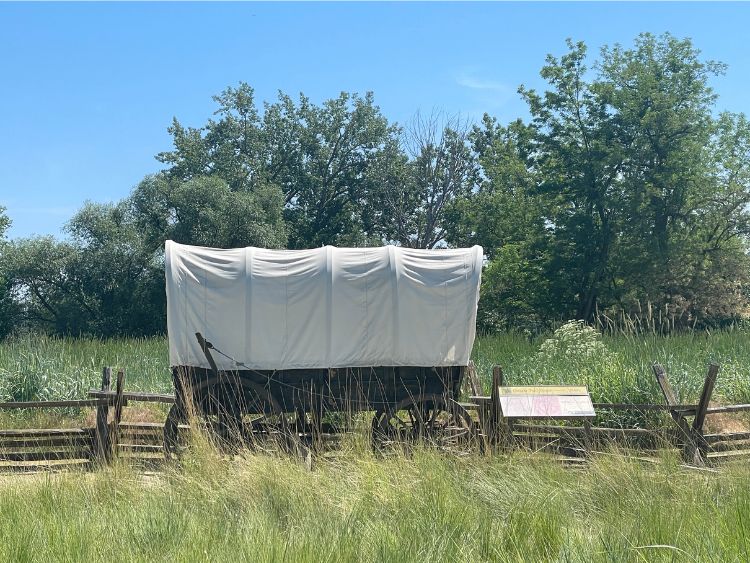
Whitman Mission National Historic Site
Then make your way to the Whitman Mission National Historic Site. Start at the visitor center to peruse the exhibits. Check out the film about the Whitmans, which provides ample background regarding the couple, their work and untimely deaths.
In 1836, the Whitman couple traveled from New York to Washington to open a Christian mission for the Cayuse tribe. Marcus and Narcissa Whitmas were among the first American settlers in the West. They played an important role in opening the Oregon Trail. They aimed to Christianize and “civilize” indigenous populations, including the Cayuse, who still consider this area their homeland.
By the early 1840s, it was clear that the Whitmans had been unsuccessful in their goals. The mission doubled as an Oregon Trail stopover, offering nourishment, medicine, and shelter to new immigrants in the winter. Marcus, a practicing physician, cared for new immigrants and the Cayuse, seeing physical health as vital alongside his spiritual ministry.
The Demise of the Whitman Family
Problems began to arise when the new settlers brought diseases with them. They came to a head when an epidemic of measles killed half the Cayuse population. A small group of the tribe met on the evening of Nov. 28, 1847 to discuss options to stop the spread of death, coming to the conclusion that Whitman was the problem. They suspected he failed to cure them as a way to acquire their land and make way for new settlers.
The next day, though Whitman had been warned of plans to kill him, he did nothing. By evening, he and Narcissa were dead and within days, eleven more people were killed. Plus 47 others, including children, were held hostage until December 24th.
Months later, settlers organized a militia to seek revenge for the killings which resulted in the Cayuse War. Eventually, the Cayuse gave up five of their men for the murders at the Mission. The men were convicted despite any evidence and were subsequently hanged.
The murders of the Whitmans set off a series of devastating events that ultimately forced indigenous populations onto reservations.
Take the Trails to Explore the Site
To view the site, take the Whitman Mission NHS Mission Trail, which takes you past the Whitman’s two homes, a re-created millpond and the other buildings of the mission. The buildings, however are no longer standing, but the foundations are outlined by cinderblocks along the trail.
Continue your exploration by walking up the Gravesite and Hill Trail, leading past the Great Grave and other gravesites to the top of the peak, where a memorial obelisk was placed in 1897.
Read More: Getaway on Washington’s Whidbey Island
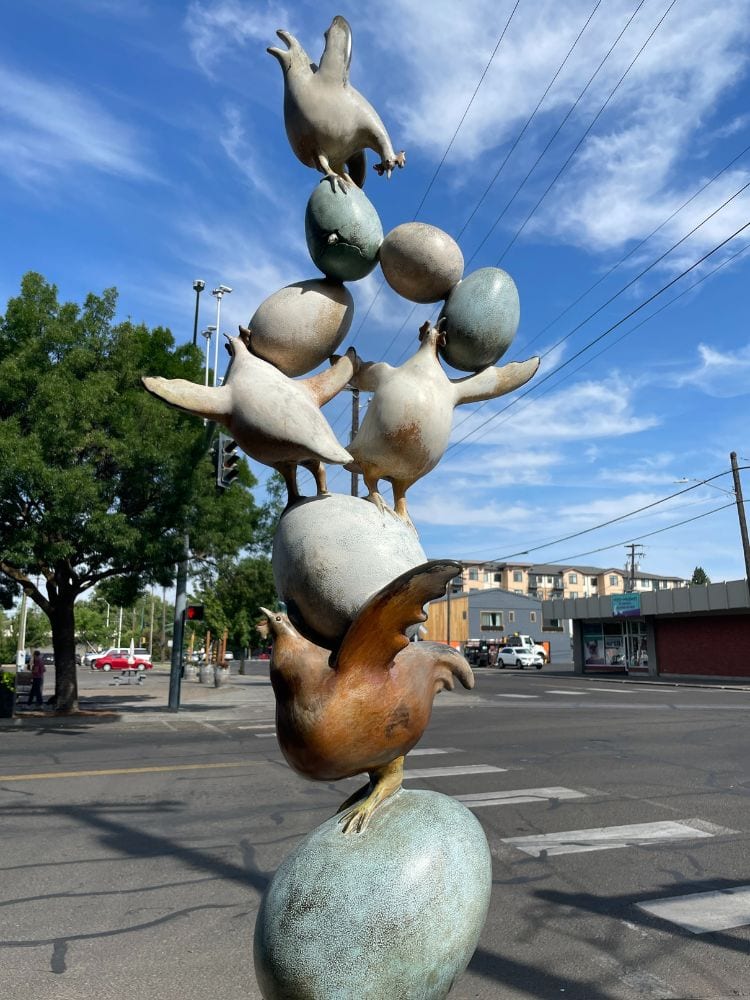
Artful Walla Walla
Art abounds in Walla Walla, with galleries, outdoor sculptures and murals dotting the downtown area. Many of the pieces are bronze, casted by the world-class Walla Walla Foundry.
Some of my favorites are “The Thinker, a bronze frog by Ralph Tretheway, which offers a whimsical twist to Auguste Rodin’s famous sculpture; “A Delicate Balance,” by Wayne Chabre and Jeanne McMenemy, featuring a playful balancing act posing the age-old question of whether the chicken or the egg came first; and Brad Rude’s “Thoughts Discovered,” which portrays a dog carefully balancing objects on his nose.
It’s hard to miss “Windows on the Past,” a full scale, colorful public art installation in Heritage Park, right off Main Street. It’s comprised of historic and contemporary photos from various groups who lived in the Walla Walla Valley from 1850-1950. The photos have been reproduced in porcelain enamel on steel panels and inlaid on the facade of Henry Osterman’s 1902 Odd Fellows’ Temple.
Images range from a Chinook salmon and pictures of local Native American tribal members to a picture of two local Whitman College students, one being William O. Douglas – yes, the same Douglas, who became a U.S. Supreme Court Justice. Opposite this mural is a large painting of historic storefront facades that stretches across the side of a building.
And then there are the murals in the parking lot of the Walla Walla Public Library. On one wall are fictional children’s book characters like Harry Potter and Clifford the Big Red Dog. On the other side of the lot is the “Wall of Words,” with quotes from such authors as J.K. Rowling, Harper Lee, William Shakespeare and more, painted on larger-than-life book spines. Rowling’s words, “When in doubt, go to the library,” made me smile.
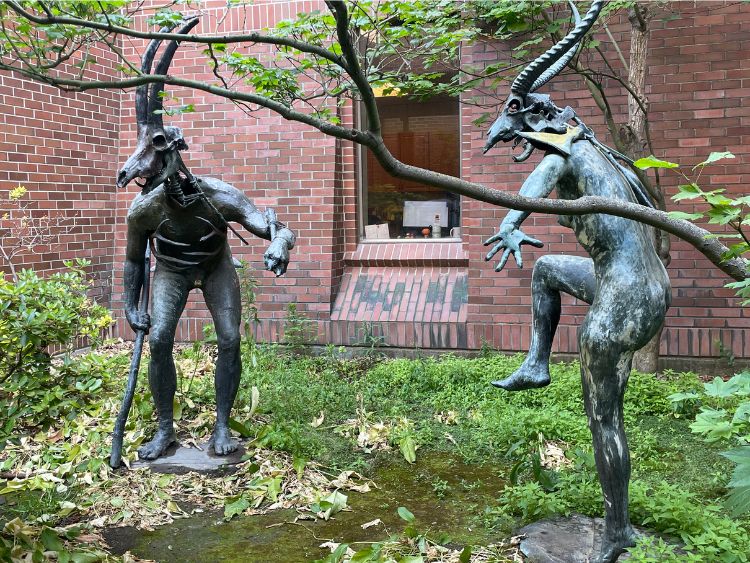
Stroll Around Whitman College for More Eye Candy
For more outdoor art installations, walk over to nearby Whitman College, where you can take a self-guided tour of the twenty plus sculptures adorning the lush campus grounds, many of which were commissioned by graduated classes or created by alumni.
The college has a long history, as it was established in 1847 in the Whitmans’ honor, first as a seminary and later as a four-year, degree-granting institution.
Several pieces stood out for me: Jim Dine’s “Carnival,” a Pop Art style statue of Venus carved from one tree using a chain saw, then cast in bronze; “Styx,” by Deborah Butterfield, who is known for her equine imagery pieces constructed from found objects or natural elements; Frank Munns’ “American Satyr” and “The Mistress of the Wild Beasts,” a pair of impish figures – the male was cast from the artist’s own body; “Three Stories” by Walla Walla artist Squire Broel, which is said to have been informed by Broel’s strolls through Hong Kong fish markets; and “Topophilia Gates,” a stunning set of fused glass panels set amid a shady stretch of stream, by Keiko Hara. I loved how the water from the stream flowed through the arches.
Enjoy a Live Production in the Historic Gesa Power House Theater
If you haven’t gotten your fill of culture yet, take in a production at the historic Gesa Power House Theatre. This is where you can see live dance and theatrical performances, comedy shows, musical concerts and films.
The 120-year-old building, which is on the National Register of Historic Places, was once the Walla Walla Gas Plant, constructed to produce coal gas to light the town. In 2011, it was transformed into a state-of-the-art, 300-seat venue with an interior design inspired by Shakespeare’s own Blackfriars Theatre in London.
Explore the Great Outdoors
Active visitors will appreciate Walla Walla Valley’s scenic beauty and the endless opportunities to hike and bike its many trails. Right in town is Pioneer Park, with its ponds, walking paths, picnic areas and even an aviary.
Just five miles out of town is Bennington Lake, where there are miles of trails to hike, a lake to paddle in and vistas of the Blue Mountains. About an hour away is 94-acre Palouse Falls State Park, home of the Palouse Falls, Washington’s own state waterfall, where the water plunges 200 feet down into a whirling pool.
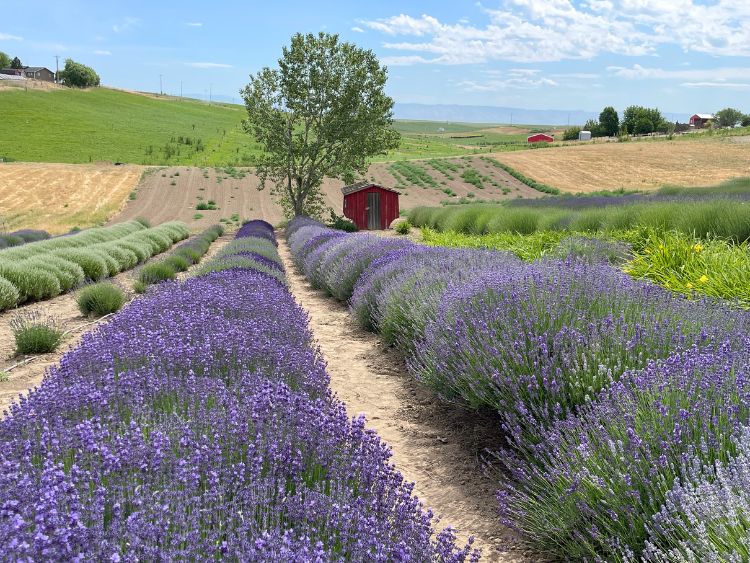
What’s that Heavenly Aroma? It’s the Blue Mountain Lavender Farm!
If you happen to visit in June or the beginning of July, put Blue Mountain Lavender Farm on your list. This agro-tourism operation is a must-see.
It’s owned by the Grimaud family, who following the decision to cultivate a rural lifestyle, moved from France to the U.S. in 2000. They eventually landed in the Walla Walla Valley on ten acres of rolling hills, where they proceeded to grow three types of lavender, France’s quintessential crop.
You can pick your own lavender and purchase an array of artisanal lavender goods from the Farm Boutique, including dried bouquets, sachets, essential oil, bath and body products and culinary treats.
Or, you can simply take in the sublime scene of lavender fields in all their glory from a chair on the patio, as you sip a glass of lavender lemonade. Photographers and painters will be in heaven with the Impressionistic-like landscape.
Amazing Food Options in Walla Walla
Anywhere there’s good wine, there’s sure to be good food. And Walla Walla doesn’t disappoint in this arena. Cafes, bistros and restaurants abound, with plenty of options galore.
Start your day at Bacon & Eggs for a hearty breakfast of shrimp and grits, omelets, Benedicts, biscuits and gravy or stuffed brioche French toast. And if you’re in the mood, accompany your meal with one of the all-day cocktails, like The Morning Paper, a meld of gin, St. Germain and grapefruit juice with a prosecco float.
Come lunchtime, take a seat at TMACS and enjoy an array of seasonal creations. The menu includes such dishes as wild salmon cakes, ahi tuna BLTA, Wagyu burger, salads, pastas and more.
On the libations side, the bar offers crafted extracts and mixers, smoke infusions and rare ingredients. You’ll definitely want to return later for happy hour.
Craving a taste of Paris in Walla Walla? Brasserie Four has you covered. This charming café specializes in classic French flavors with the traditional dishes you know and love, like mussels and frites, steak frites, French onion soup, vichyssoise and beef bourguignon. If the weather cooperates, dine on the patio for streetside ambiance and people watching opps.
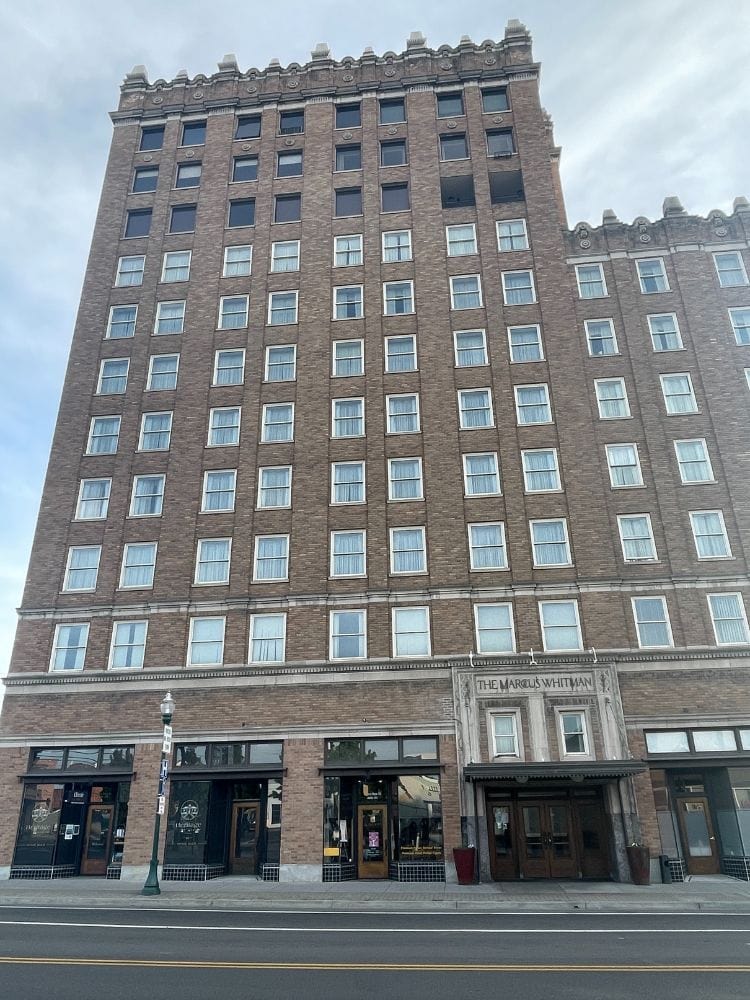
Stay at the Legendary Marcus Whitman Hotel
Homebase during my stay was at the Marcus Whitman Hotel. This 133-room, historic property, which opened in 1928, is Walla Walla’s Grand Dame. It’s been the site of many conventions and meetings, and over the years, presidents, dignitaries and celebrities have graced its doors. Classic elegance and style of the period, combined with cutting-edge technology and a convenient downtown location, make it the hotel of choice for many visitors and business people coming to Walla Walla.
Rooms are well-appointed in the Renaissance style, featuring Italian crafted furnishings, comfy beds with plush linens, Gilchrist & Soames bath products, complimentary high-speed Internet and other amenities.
Dine at The Marc
For that special, farm-to-table dinner in an Old World atmosphere, dine at The Marc, the hotel’s top-rated restaurant. Gourmet dishes are created with an eye to using local ingredients, as well as veggies and herbs from the restaurant’s rooftop garden. Start with the Cosmic Crisp Salad or crab cakes, before diving into delectable Pacific salmon, half chicken or slow-braised pork shank entrees. Finish your meal with wild berry cobbler, a la mode, of course! Service is friendly and attentive in the handsome dining room.
Dine at Vineyard Lounge
For a more casual atmosphere, head to the hotel’s Vineyard Lounge with its tapas-style menu, local wines and specialty cocktails. In the summer, sit on the patio for an al fresco experience.
A new investment group purchased the Marcus Whitman in Dec. 2022 and some exciting renovation plans are in the works as the hotel celebrates its 95th year in operation. It sounds like the Grand Dame of Walla Walla will become even grander!
Read More:
Debbie Stone is an established travel writer and columnist, who crosses the globe in search of unique destinations and experiences to share with her readers and listeners. She’s an avid explorer who welcomes new opportunities to increase awareness and enthusiasm for places, culture, food, history, nature, outdoor adventure, wellness and more. Her travels have taken her to nearly 100 countries spanning all seven continents, and her stories appear in numerous print and digital publications.
- Together at Sea: A Mediterranean Family Adventure - April 27, 2024
- Travel Guide to Colorado - April 26, 2024
- Travel Guide to Croatia - April 26, 2024

